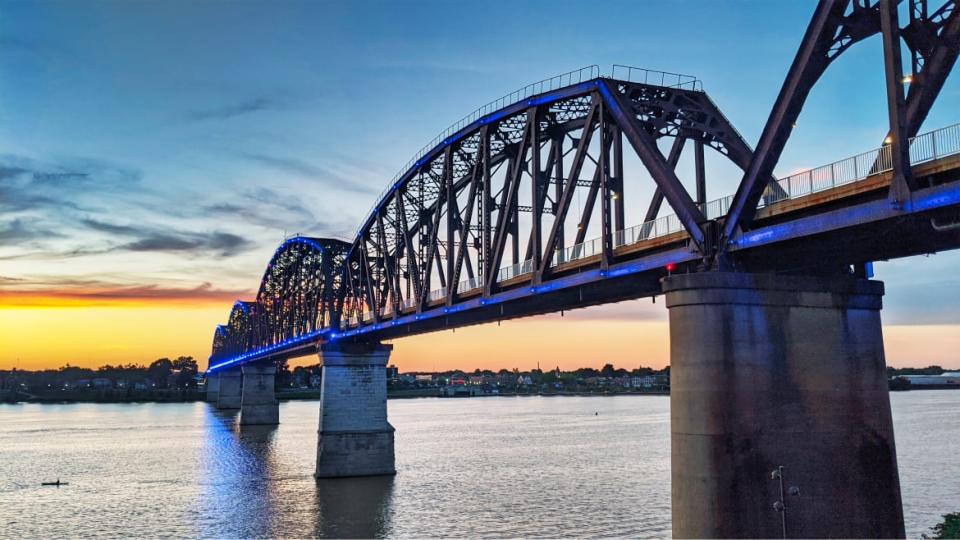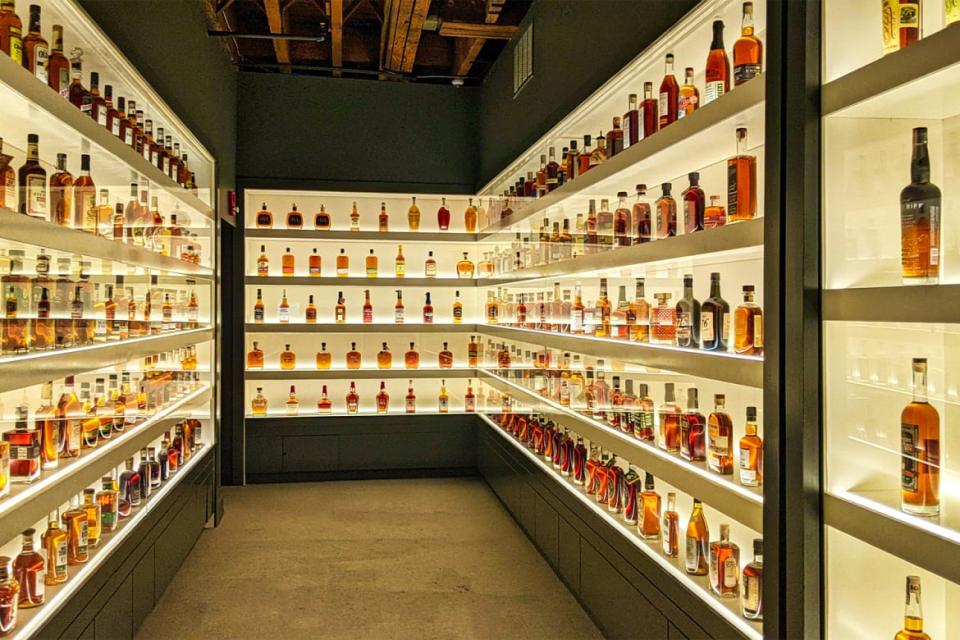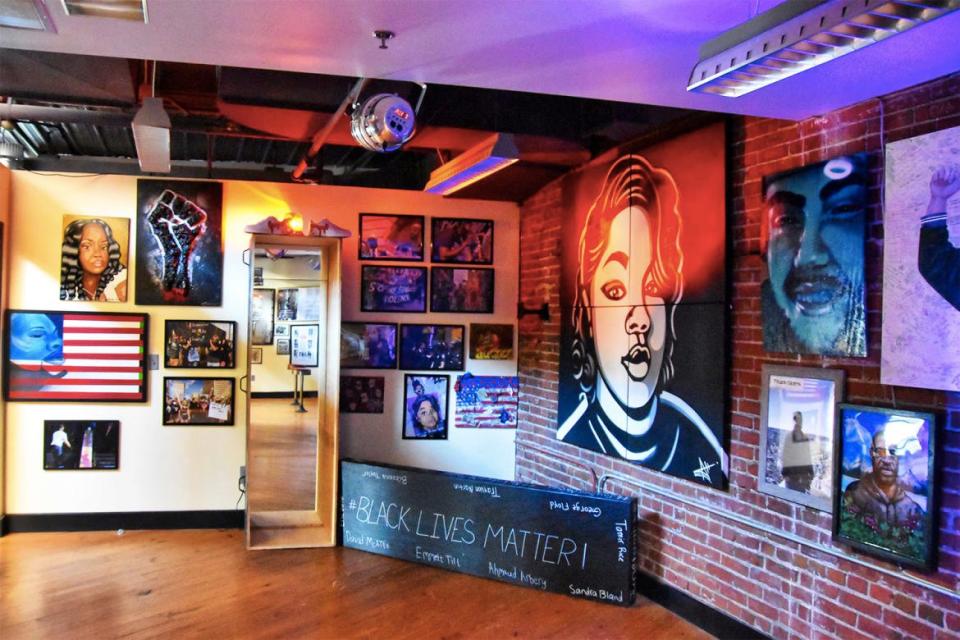This City is Much More Than Its Booze

This is the latest in our twice-a-month series on underrated destinations, It's Still a Big World.
Where can you find a giant 120-foot baseball bat leaning casually up against a building, a trail dedicated to bourbon that wraps through a city, or a zipline running though underground caves?
Louisville, Kentucky. (Yeah, you read that right.)
I haven’t been to Louisville in years, aside from trips around the city on the way to other cities—and Louisville is only four and half hours from home. At the invitation of Louisville Tourism, I decided to see the city with fresh eyes. For three days, I set out to absorb as much of the Louisville vibe as I could. I ate and drank a lot. But I also discovered a city that is more than bourbon—one demanding much more than a passing nod from the interstate.
The Grady was my home away from home while I was there. A boutique luxury hotel, it had opened mere weeks earlier in May. Rooms (starting around $245) have high ceilings, comfortable king beds, white subway-tiled bathrooms, and are decorated in themes related to Louisville history.
The hotel building has a long history in Louisville going back to 1883, when it was the offices of pharmacist J.B. Wilder. And by pharmacist, I mean that he treated ailments using medicinal bourbon bitters and elixirs. (Yes, one prescription for bourbon, please.) In the 1920s, it became the Swann-Abram Hat Company, maker of Kentucky Derby hats. (You can, and I did, tour Churchill Downs, home to the Kentucky Derby.)
The hotel restaurant, Wild Swann Restaurant and Bar, is a stylish homage to the speakeasy with the apt slogan, “food, but mostly booze.” The menu has shareables (Kentucky Lamb Chops, chicken lollipop fricassee) and plates (like Kentucky buffalo sliders or cauliflower steak), but drinks rule the menu, with an extensive list of beers, wines, and whiskies, and some refreshing cocktails, like the Gold Rush (rye with fresh lemon and honey, served on the rocks). There is also plush seating in a catacomb-like space.

The Grady Hotel
The Grady is centered within the cultural and entertainment side of the city. The Muhammad Ali Center is next door, which gives visitors a stunning window into the story, passions, and struggles of a boxer who approached life on his own terms, even while suffering from Parkinson’s disease.
The Louisville Slugger Museum & Factory is also nearby. There you can learn about the history of the baseball bat and watch it being made. The Museum & Factory is not hard to find — just look for the building-sized baseball bat. I’m not into baseball, but I found the process of manufacturing the bats, including the ability of players to order their own customized bats, fascinating.
But if it is “medicinal” bourbon you need, the bourbon district is central to downtown.
Begin your bourbon experience with the Frazier Kentucky History Museum, which is not only an introduction to Kentucky history, it is also the official start for the Kentucky Bourbon Trail Welcome Center. From there you can get a history of bourbon, maps of the trail, a passport to get stamped at distilleries, and learn how it’s made. For bourbon to be bourbon, for example, it must include 51 percent corn and age in charred white oak barrels. Kentucky has the added advantage of its water being filtered through limestone, which filters out the iron and sweetens the flavor.

Bourbon Exhibit The Frazier Museum
The love of that sweet flavor turned Louisville into Bourbon City, and by the end of the nineteenth century, Main Street was called “Whiskey Row” — home to 75 Bourbon distillery warehouses.
In the 1920s, Prohibition all but killed this “Wall Street of Whiskey,” but there were loopholes. Like marijuana, some distilleries were allowed to continue to produce whiskey for medicinal purposes. Suddenly, everyone needed a script for whiskey (or even their pets). The Old Forester distillery, whose public tour is running again, was the only bourbon that was continually sold before, during, and after Prohibition. The tour ends with a bourbon flight tasting.
Restaurants also line Bourbon Row—like Merle’s Whiskey Kitchen, which has bright hand-crafted cocktails and Southern comfort and soul food—but other options can be found throughout the city.
La Bodeguita De Mima, in the nearby affluent and trendy Nulu (New Louisville East Market District), is a lively Cuban restaurant run by the first-generation immigrant Fernando Martinez and his cousin Yaniel Martinez. Four Pegs Smokehouse & Bar in Germantown smells and tastes like heaven. Their pulled pork is tender and juicy and if you eat it on the patio area between their two meat smokers you’ll get to marinate as well.
If you need to work off those calories in a way that doesn’t just mean walking to the next distillery, there are outdoor experiences waiting for you, like biking the Louisville Loop Trail.
When completed, the Loop will be a 100-mile trail that loops the city, beginning with the Big Four Bridge, which now serves as a pedestrian and bicycle bridge that connects Louisville to Indiana. The remaining trail winds through neighborhoods and parks, many of which were designed by Frederick Law Olmsted, the same creative brain behind New York’s Central Park.
Don’t have a bike with you? No problem.
I picked up my bike rental from Scheller’s Fitness & Cycling and biked a beautiful stretch of trail through The Parklands, a lush greenspace of fields and forest, which has 60 miles of hike-bike trails (as part of the Louisville Loop) and 22 miles of paddling trails that connect several parks together seamlessly.
The biggest surprise for me was discovering that Louisville is home to a massive underground cavern through which you can zipline.
The Louisville Mega Cavern, a former limestone quarry, has 4,000,000 square feet (approximately 100 acres) of space through which you can zipline. The Mega Cavern is a reinforced space, complete with roads, structures, and supports, leaving it with its own building code and making it technically the largest building in Kentucky.
At Mega Cavern, I made two thrill-seeking friends—Peg Morrison (68) and Debbie Booth (63).
“This is a bucket-lister,” Morrison told me. As I learned more about her, ziplining through underground caverns made sense. Morrison is a retired RN and now owner of WOW Fireworks Productions, which she tells me stands for “Wild Older Women.”
“We are pyrotechnic artists,” she told me. “We paint the sky with fire!” Her brother passed away recently, she told me, just before she jumped at the first zipline called the Zipline to Hell. “He wants some of his ashes sent up with a shell and exploded at a family gathering.”
Mega Cavern’s ziplines progressively grow longer and higher, which helps nervous guests adjust. One of the final ziplines is as long as the Titanic, and deep enough the others can be seen ziplining below you. At the end, you can choose a partner to race for one final round. No one is ever trapped below and forced to complete the ziplines, because at any point you can request an easier exit.
But Louisville is more than bourbon, bikes, and ziplines.
One stop from this trip still lingers with me, and that is Roots 101: African American Museum. During the pandemic, and after the tragic killing of Breonna Taylor, Louisville became known as a center of Black Lives Matter protests. Opening in its new building near the Distillery District in June, Roots 101 is setting the record straight on Black history and racism in America.
“We call it a healing space,” said founder Lamont Collins, “because it is the one time that I can look people in the eye and tell them my history, because America’s never told it — it breaks down the myth of [white] supremacy.”

Roots 101 Museum
The museum sets out to explore the African American story and experiences from Africa until today, and it does so boldly and clearly. America’s enslavement of Africans and centuries of PR aimed at promoting the myth of white supremacy is undeniably part of that story and it is told in all of its pain and tragedy at Roots 101.
But that myth of supremacy is demolished as the museum unravels the real legacy of Black Americans as contributors to American progress and competitors on the world stage. This stood out to me in a section on sports, which Collins calls “the great equalizer.”
As Collins explains it, you can make any claim about who was the best athlete, but the statistics don’t lie. They set the record straight on equality.
This point of "the great equalizer" stayed with me, because as Collins and I spoke, I had a chance to also meet artist Ed Hamilton. Hamilton's sculptures can be found throughout Louisville, but he is nationally known for his African American Civil War Memorial sculpture in Washington, D.C.—“Spirit of Freedom.” The sculpture is a tribute to Black soldiers who served in the Civil War alongside white soldiers, which, he reminds me, is equality on the battlefield.
Louisville is the intersection of all America. It is an evolving city that messes with your expectations, making it worth it to get off the expressway and look around—and maybe get that script for bourbon filled.
Get our top stories in your inbox every day. Sign up now!
Daily Beast Membership: Beast Inside goes deeper on the stories that matter to you. Learn more.

 Yahoo Finance
Yahoo Finance 